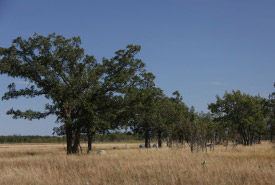It takes an (effectively communicating) village: The importance of information exchange between researchers and conservation practitioners

Tall grass prairie, Manitoba (Photo by NCC)
As a general rule, tall grass prairie researchers and conservation practitioners are a fairly lively bunch. They’re very passionate and not shy to share their perspectives on how, why and what conservation actions should occur. They understand that their work is important and urgent — after all, the tall grass prairie is one of the most imperiled ecosystems on the planet.
Occasionally, however, all of us can get too close to our subject matter and forget that there may be other perspectives/species/objectives that are equally as valid and grounded in evidence.
In the conservation business, as with most things in life, personal relationships are key to long-term success...I’ve found that when on-the-ground conservation practitioners, land managers and researchers are in one room with lots of opportunities to share perspectives and connect evidence, a better and deeper understanding of ecosystems and the best methods to conserve them can emerge.
So when it came time for the Nature Conservancy of Canada (NCC) to renew the five-year conservation plan for the Tall Grass Prairie Natural Area, we decided to invite some of the leading researchers and practitioners whose work focuses on this habitat and the species within it to come spend the day with us at the Weston Family Tall Grass Prairie Interpretive Centre.
To the untrained eye, the tall grass prairie may just look like a vast expanse of…tall grasses. But this ecosystem represents the product of myriad dynamic ecological processes and influences such as hydrological flow, natural disturbances, past land use, species interactions, topography and varying soil types. NCC and our partners have learned a lot about how to conserve and manage this complex system, but there is still much to be understood. The workshop agenda was designed to allow for a brief overview of the literally dozens of separate research projects and land management experiments that can be going on at any one time in the Tall Grass Prairie Natural Area.
Over the course of one day, university, government and not-for-profit sector researchers and conservation practitioners shared findings on pollinators (including the threatened Poweshiek skipperling), species at risk such as the western prairie fringed orchid and least bittern, hydrology, range management, prairie restoration, invasive species, fire management, information management and more.
Several common threads emerged. The first was that NCC has an important role to play in tall grass prairie conservation — direct land protection and subsequent stewardship are key to the long term-conservation of the tall grass prairie. The importance of understanding the complex, interconnected nature of this system came up in many discussions (for example, how best to incorporate insect pollinators into prairie restoration projects, the role of near-surface groundwater flow in orchid conservation).
Second, we discussed how many research studies are indicating that the area is getting wetter — the result is a relative increase in wetland species (especially plants and birds) and a decline in species with an affinity for dry prairie. These and other results led to subsequent discussion and several new ideas about how best to practically and effectively conserve and manage lands in this dynamic ecosystem, as well as what key research questions remain to be explored.
In addition to providing a venue to reconnect with partners and forge new friendships, I had a chance to show off our new Weston Family Tall Grass Prairie Interpretive Centre and its suitability as a unique meeting venue, teaching location and home-base for researchers. Researchers were also provided information on how to apply for research permits and with a listing of local businesses that would be eager to supply their equipment, repair, food and entertainment needs.
At the end of the day, this experience drove home to me the importance of information and perspective sharing amongst all key players involved in landscape-scale conservation. Information shared in a concise and accessible manner, with lots of opportunity for discussion and comparison of ideas and experiences, has the best chance of being understood and acted upon.
The end result is a stronger, more informed conservation community that is best able to author long-term, measurably effective biodiversity conservation success.


